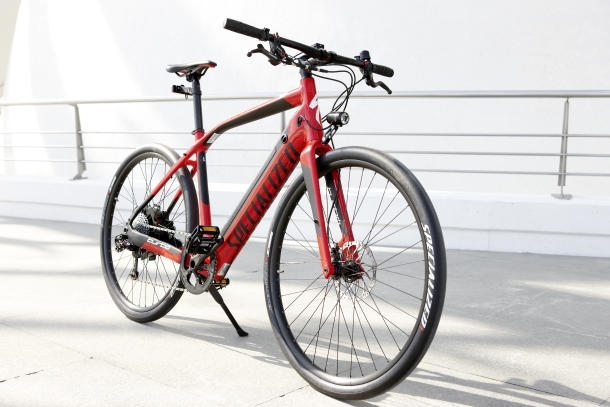The last time I’d found myself astride an electric bike was over four years ago, when CNET reviewed the Schwinn Tailwind in March of 2009. That bike was jerky and awkward, very heavy, and a bit of an eyesore.
Fast-forward just under half a decade to April 2013, when I find myself standing in front of the sleek, red frame of the new Specialized Turbo. Electric bike, you’ve come a long way, baby.
Design
The Specialized Turbo is a good-looking bike. Period. And I don’t just mean “good for an electric bike.”
The bike blends road/racing bike looks with commuter bike proportions. It looks fast but rides comfortably. For example, the top tube slopes downward as it sweeps back from the front of the bike, flowing smoothly into the rear triangle seat stays, but more importantly freeing up valuable crotch space and stand-over clearance when stopped and straddling the bike.
The straight handlebars are your first hint that this bike and its upright riding position is best suited for a race to the office rather than to a finish line. On this bar, you’ll find an SRAM DoubleTap thumb shifter for clicking through the Turbo’s 10-forward gears, brake levers, a cycling computer, and thumb controls for the e-assist system, which we’ll get back to in a bit.

At the front and rear ends, you’ll find lightweight 700c wheels shod in low-rolling resistance tires that have an odd, smooth finish that makes them look a bit like naked inner-tubes to my eye. The Turbo hauls itself to a stop with front and rear disc brakes and, at its most basic, gains forward propulsion from your legs spinning the cranks.
Turbo electric assist system
Take a close look at the Specialized Turbo and you’ll see that the downtube — that’s the one that angles down from the front of the bike towards the pedals — is significantly thicker than the other tubes that make up the frame. That’s because the downtube houses the 342Wh (watt-hour) battery pack.

The cylindrical battery is locked into place and can be removed from the bike with a key. You have two options for charging the battery.
The first is on-bike charging, achieved by removing a magnetic cap from the downtube and connecting a proprietary charging cable directly to the bike. This is good for times when you can bring the entire bike indoors, such as your own dwelling at night.
The second option is to remove the battery from the bike and plug the charger directly into the cylindrical pack with the same cable. This is good for times when you can’t bring the whole bike with you — for example, the bike can stay in a secure bike room at the office while the battery charges at your desk.
Both charging options take about four hours to top off a completely drained battery.

Power from the battery pack is sent to a hub motor on the rear axle that provides electric assist when it senses that you, the rider, are pedaling forward. Specialized kept repeating that the Turbo was supposed to feel like “you, only better” — the idea being that the electric assist gives the sensation of the cyclist being just a bit stronger than he or she actually is, sort of like a good tailwind or a slight downhill incline.
The rider is given the choice between four electric assist modes. In Turbo mode, the electric motor gives its full 250 watts of available assistance. Eco mode reduces that output to about 30 percent, or about 75 watts, for increased range. There’s a No-assist mode that lets your legs supply 100 percent of the forward thrust. Finally, in Re-gen mode, the electric motor applies drag to the rear wheel to help recharge the batteries. You do not want to be riding around in Re-gen mode unless you’re coasting down a long hill. Applying the rear brake automatically shifts the bike into Re-gen mode until you release the lever.

Specialized assured me that the electric system is completely waterproof and will work in subzero climates and at triple-digit temperatures. In a word, this bike should be safe. Just wear your helmet and keep your head on a swivel.
How far the electric assist will last you is a bit tricky to explain.
On the road
Explaining the Turbo’s range is a bit tricky because of that specific “electric-assist” bit of nomenclature. You see, the bike never really runs on 100 percent electric power. The rider is always supplying a portion of the forward thrust — part of that whole “you, only better” mantra. So the range you’ll get from the Turbo’s battery pack depends on a number of factors, from your leg strength to your gear selection out of the 10 available, to the amount of coasting or climbing that you encounter. Specialized tells me that you’ll get about an hour’s worth of cycling, but the number of miles that you can cover in those 60 minutes will vary.

The Turbo has an estimated full-assisted top speed of 27 mph, so let’s assume that on a perfectly flat road with no stops, you could eke 27 miles out of the battery. My testing took place on an approximately 11.7 mile loop, starting on San Francisco’s Embarcadero, taking us through a fast blast through the Marina district and over a pretty serious climb near the Golden Gate bridge. It used 62 percent of the battery, which seems to back up that range estimate.
Once the battery runs out, the Turbo reverts to being a standard leg-powered bicycle, so technically the range is limited only by your physical fitness.
Specialized has done a pretty good job of making the electric assist mostly seamless once you’re moving, but I ran into a bit of unsteady lurching when attempting to mount or dismount at traffic lights. The bike never felt dangerous, or like it was getting away from me, but the sensation took some getting used to. I’d recommend that any cyclist do their first few starts in Eco mode, familiarizing themselves with the bike before blasting off with the full Turbo.
Track stands at stop lights are difficult, but not impossible. Thanks to the electric assist, however, highly technical moves like this are more a matter of finesse than leg strength.
Once underway, the Turbo is a revelation. The way that the bike accelerates and holds speed is, frankly, unbelievable. Our demonstration group was flying past spandex-clad cyclists hunched over their road bikes without breaking a sweat, in an upright position, and in relative comfort. My personal top speed of 24.8 mph was just below the stated maximum 27 mph. Hills were a non-issue and, to a degree, so was gear selection. With the full support of the Turbo mode’s assist, pulling away from a stop in top gear was just as easy as it was in first gear. Gear selection became more of a range conservation and comfort concern than a necessity for maintaining speed.

The disc brakes slowed the bike quickly when necessary, and though I had my reservations about the smooth tires, the bike was nimble enough to carve city corners and weave through traffic with nary a slip — although I would still still be leary of the slick trolley track and embedded Muni train tracks embedded in San Francisco’s downtown streets.
More important than the outright speed was the effortlessness that the electric assistance afforded. I ride my bike to work almost every day, and almost every day I show up damp with perspiration. I was amazed to find that after an 11-plus mile ride at an average speed of just over 14 mph, I’d not even broken a sweat.
San Francisco is a town known for its hills, but the Specialized Turbo doesn’t care about hills. It allows any rider to make up for fitness deficiencies while still getting some of the fitness benefits of riding a bike — not to mention the fuel savings and sanity savings of not having to find a parking spot in a crowded urban environment. I could definitely see myself riding one of these to work and around town daily.
What’s the catch?
However, the Turbo isn’t without its drawbacks. For starters, the thing weighs 50 pounds. Specialized itself admits that this is a hefty bit of kit, but in a sizzle reel that preceded our ride, showed a guy carrying the Turbo down stairs. Call me lazy, but I would not want to shoulder this thing up or down three flights of stairs like I do with my current bike — itself no featherweight at about 22 pounds.
Fortunately, once both wheels are on the ground, the electric assist more than makes up for the heavyweight, and you won’t really feel the bike’s mass unless you go trying to bunny hop curbs.
The other issue is the price. At $5,900, this bike is an expensive purchase and is targeted at a very specific niche of bicycle commuters who can afford to spend a lot of money on a bicycle and don’t mind doing so.

Now, I know a lot of guys and gals who ride around on $200 bikes who would gasp at paying that much for a set of wheels, but I also know people who commute into work on $4,000 carbon-fiber race bicycles. So whether the Turbo is overpriced or not is highly subjective. I’m sure that there are a number of potential riders who would like to be able to ride more, who have the disposable income of the spandex set, but perhaps aren’t as physically fit or willing to shower at the office.
Here’s how I look at it. In a densely packed city like San Francisco, a bike isn’t just a bike. For many riders, a bike is also a reasonable replacement for a car. It’s not hard to put myself in those shoes, because they are my shoes. Spending $15,000-plus on a compact car that brings with it the headaches of parking and paying for fuel versus springing $6,000 for a damn fine electric bike that could get me anywhere I’m going just as fast, if not faster is not a tough choice. Living in a city like SF, I have to say I’d pick the bike.










